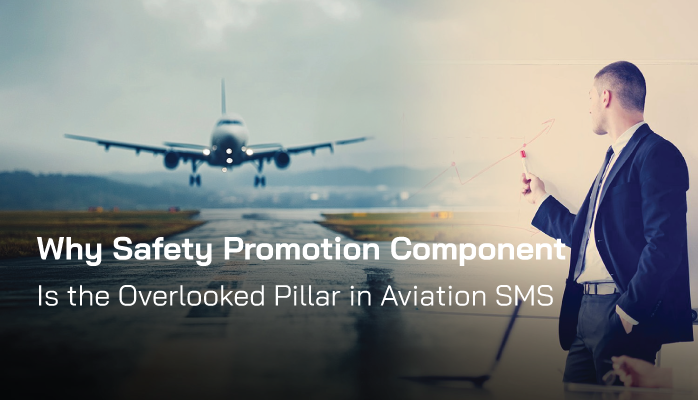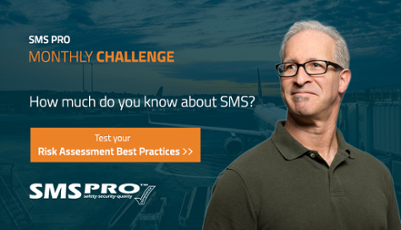What Is Safety Promotion Component of 4 Pillars?

Aviation safety management systems (SMS) have been required by most aviation service providers since the November 2006 ICAO mandate. To add structure to SMS implementations and to educate safety professionals, ICAO provides SMS implementation guidance in the form of a Safety Management Manual (SMM), now in the fourth edition.
In the SMM, aviation SMS implementation requirements are logically grouped under four components (also known as four pillars):
- Safety Policy;
- Safety Risk Management (SRM);
- Safety Assurance (SA); and
- Safety Policy.
The four components, or pillars, are further broken down into twelve elements, with between two and five elements for each pillar. The Safety Promotion pillar has two elements:
- Training and education; and
- Safety communication.
Related Articles on Four Pillars in Aviation SMS
- What Are the 4 Pillars of SMS?
- Who Started Four Pillars of Safety Management in Aviation?
- History of Aviation SMS and Four Pillars - With Free Tools
Safety Promotion Pillar Not Ardently "Promoted"
In aviation SMS discussions and literature, the Safety Risk Management (SRM) and Safety Assurance (SA) pillars receive by far the most attention.
Lagging behind them is the Safety Policy. One can reasonably justify why the Safety Policy pillar does not capture or maintain long-term attention. The safety policy pillar focuses on the structure and accountabilities of the aviation SMS, both features that one logically correlates with starting a new "safety initiative."
But why is safety promotion always the laggard? All safety managers and accountable executives must understand that every successful SMS is supported by:
repeatedly broadcasting safety messages that resonate with line employees who constantly monitor safety activities and report safety concerns.
Without safety promotion activities, there will be insufficient fuel (reported safety issues) to drive the SA and SRM processes.
We can also logically explain why SRM and SA retain long-term attention from most aviation organizations.
Why SRM and SA Processes Command Long-Term Attention
Perhaps the attention to SRM and SA is justified as these two components are critical to understanding the aviation SMS' risk management processes. SRM is the design of your "system" and SA risk management processes focus on monitoring the system for safety anomalies. While an SMS' objective is to reduce risk and improve system safety, SA processes are also capable of discovering and managing opportunities to initiate system improvements to reduce risk to as low as reasonably practical (ALARP).
So while SRM and SA risk management processes can be considered "critical" components for a successful design, we must not be too hasty to discount the other two SMS components. Aviation SMS is a "system" and in this "system," there are no extraneous, optional components, despite management's dismissive attitude toward safety promotion.
Related Aviation Safety Promotion Articles
- 10 Best Ways to Promote Safety in Your Aviation SMS [With Free Checklist]
- Why Safety Promotion Requires More Focus in Aviation SMS
- Best Ways to Promote Safety in Your Organization (With Free Resources)
Industry Leaders Also Discount Safety Promotion by Omission
Unfortunately, SRM and SA get the most attention in SMS implementation guidance distributed by civil aviation authorities and other standards-setting bodies, such as IS-BAO and IATA. You will see volumes of great advice devoted to these two pillars. Then, the way in the back, sometimes barely noticeable, is safety promotion. To put it in perspective, in the FAA’s Advisory Circular:
- Safety Policy receives 6 pages of coverage:
- Safety Risk Management receives 12 pages of coverage;
- Safety Assurance receives 15 pages of coverage; and
- Safety Promotion receives 3 pages of coverage.
Safety promotion is also a very difficult element for aviation SMS auditors to evaluate. Who is to say "What is an appropriate safety promotion strategy" for any given company? As long as there are some indicators of safety promotion activities, an operator seldom receives findings relating to safety promotion. Most SMS auditors will focus on the other three pillars, as they can be more "objectively" evaluated. Safety promotion, just like safety culture, is evaluated in a highly subjective manner.
What Are Elements of Safety Promotion in Aviation SMS

In the shadow of SRM and SA, it’s easy to overlook just how important safety promotion is. This pillar accounts for:
- Safety communication;
- Safety awareness;
- Safety training;
- Safety competency; and
- Safety culture.
In short, safety promotion covers all of the mission-critical mechanisms that allow your SMS implementation to work in the operational environment. You could even make the argument that safety promotion is the most indispensable of all pillars.
Poor demonstrations of safety promotion in an SMS implementation, such as poor awareness, communication, and/or safety culture, will completely cripple any aviation SMS. No other pillar can boast such a claim.
Related Aviation Safety Promotion Articles
- How to Stay on Top of Aviation Safety Promotion With SMS Newsletters
- Aviation SMS Surveys - an Often Neglected Safety Promotion Tool
- FAA Part 5 Compliance: Safety Promotion (the "Overlooked Pillar")
Goals of Safety Promotion
In general, the primary goals of safety promotion revolve around building confidence in the SMS implementation, as well as safety in general. This confidence should arise through:
- Employees who receive proper training and feel confident in performing duties safely;
- Strong, secure lines of communication between all employees and different levels of management;
- Ongoing awareness of pertinent safety issues; and
- A demonstrable policy of non-punitive reporting supported by all managerial levels.
The above points are only helpful conceptually. But they are generalities. It's important to know "what" the above points translate to in the operational environment in tangible ways, such as:
- High percentage of employees receive SMS induction training, hazard identification training, etc.;
- Training courses feature beginning and/or end of course assessments;
- Employees are all familiar with who the safety managers are, and interact with him/her on a regular basis;
- Management regularly communicates recent safety concerns to all employees, such as with a daily email, weekly meeting, and monthly newsletter; and
- Ability for management to openly discuss (such as in safety meetings) any safety issue without receiving resistance or negative reactions.
It’s always recommended that safety management teams outline specific safety promotional goals in their policies.
Types of Safety Promotion Activities
Most promotional activities are what we call “input activities.” What this means is that they are influencing what goes in to safety performance (as opposed to Safety Assurance, which addresses what comes out of safety performance). It’s also no coincidence that a majority of aviation leading indicators address the Safety Promotion pillar.
Here are some of the most important safety promotional activities:
- SMS induction training (initial and recurrent);
- Aviation safety training that is aligned with employees' role in the aviation SMS;
- Safety meetings;
- Safety Newsletters;
- Email updates alerting employees of hazardous conditions (or other forms of such communication);
- Safety surveys;
- Sharing lessons learned with industry;
- Status boards (such as aircraft status, etc.);
- Management/employee interaction;
- Reinforcing and abiding by non-punitive reporting policies; and
- Safety culture building (such as with reward programs, etc.).
More than any other pillar, we have seen safety promotion at its most successful when companies have a dedicated calendar for promotional activities. This is because it’s easy to get bogged down in SRM, Safety Policy, and SA activities, and only practice promotion sporadically. This calendar will ensure that daily, weekly, and monthly promotional activities are consistent and your safety culture continually improves.
Related Aviation Safety Culture Articles
- What Is Safety Culture in the Aviation Industry?
- 8 Charts to Monitor Safety Culture Performance in Safety Management Systems (SMS)
- 6 Types of Safety Culture in Aviation Safety Management Systems
How to Measure Success of Safety Promotion Activities

Here’s the rub: how do you know if your safety promotion activities are working? This is a tough question with no immediately clear answers unless you have a robust SMS data management strategy, such as using an aviation safety database.
An aviation safety database allows your organization to easily monitor safety performance activities. If your SMS data management processes are not easy to follow, they will never be sustainable in the long run. Therefore, keep your processes simple. There are a few, low-cost, commercially available SMS databases that are affordable for smaller operators that support tracking safety promotion activities. SMS Pro is one of these products.
There are 3 creative ways to monitor the effects of your safety promotion activities:
- Aviation leading indicators;
- Employee performance monitoring; and
- Key performance indicators (KPIs).
In conjunction, these three activities can give you an extremely accurate picture of how effective promotional activities are. It works like this:
- Use leading indicators to monitor promotional activities over time, such as:
- Frequency of safety meetings;
- % Employees received all safety training;
- % Employees received SMS induction training;
- Employee turnover rates each month;
- Safety survey results;
- And so on...
- Compare successes/failures of leading indicator metrics to improvement/declines in each employee’s performance, such as:
- % on time CPA completion;
- Safety meeting attendance;
- Average number of hazard reports submitted per month;
- Competency of test scores;
- And so on...
- Compare success/failures of leading indicator metrics to company key performance indicators.
Having a side-by-side visual comparison of leading indicators, employee performance, and KPIs will produce solid evidence and a great understanding of what promotional activities are or aren’t translating to improved performance on an individual and company-wide level.
The most obvious metric to track is the number of safety reports submitted through your organization's safety reporting system. Whenever possible, attempt to evaluate safety reporting metrics by:
- Company wide;
- Division level; and
- Department level.
By evaluating and comparing safety reporting metrics at various levels, safety teams and the accountable executive will be able to gain insights into resistance to aviation SMS implementation. When evaluating metrics only by the company's performance, you will be leaving yourself open to having sub-performing pockets of resistance to aviation that are supported by other areas of the company that earnestly support the SMS implementation.
Why Is Safety Promotion Undervalued
So the question remains: if safety promotion is so important, why is it so undervalued?
First and foremost, oversight agencies are not making it a priority. When the FAA only allots 10% of its requirement descriptions to safety promotion and 90% to the other three pillars, it’s no wonder the lack of safety promotion is endemic in aviation SMS implementations.
Consider a couple of hard questions:
- Are you monitoring the frequency of your safety promotional efforts?
- Do you know who is attending safety meetings or how often they are happening?
- How much do employees know about current safety issues in the company?
- Do you know which departments are NOT submitting safety issues and why they are not?
Unfortunately, most companies don’t have much to say in response to these kinds of questions. Who can blame them? Oversight agencies are pushing much higher priorities on service providers so safety promotion gets lost in the weeds.
The second reason that safety promotion is undervalued is for the mentioned reasons:
- The components of Safety Promotion (“culture,” “communication,” etc.) are extremely vague and hard to measure.
Combine this vagueness with a sore lack of oversight guidance, and companies have very little incentive to make a sincere go at safety promotion. Unfortunately, this harms safety performance which is demonstrated by substandard safety reporting metrics.
Related Aviation Safety Reporting Articles
- How Aviation Safety Managers Can Improve Safety Reporting Cultures
- 5 Simple Tips to Improve Aviation Safety Reporting Cultures
- How to Trend Safety Culture Using Safety Reporting System
Final Thought: Safety Promotion Article Take Away
Ideally, this article will have helped you:
- Have a greater appreciation for the importance of safety promotion;
- Understand the disservice of lack of guidance from oversight agencies; and
- Learn some non-vague, well-grounded activities for improving and monitoring the promotion.
The "Safety Promotion" pillar should never be discounted by managers. Without the support of line employees, your aviation SMS implementation will never reduce risks to as low as reasonably possible. Safety reports are among the core inputs of every successful SMS implementation. Employees must be onboard the SMS train. Isn't this obvious to everyone?
Managing an aviation SMS' required documentation may seem overwhelming unless you have access to tools designed to handle this task. Since 2007, SMS Pro has been supporting aviation SMS implementations across the world. We recognize that if your SMS data management strategy is not easy, your SMS will suffer.
Please review these short SMS Pro demo videos to learn how we can help.
Last updated in April 2025.








